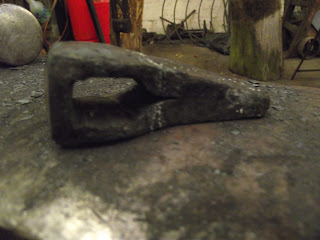recently, ive been doing some research and experimenting into the ancient methods of axe manufacture.
mostly in plastacene, which to the uninitiated is a realistic matierial for modeling in iron and steel.
ive also made some "real" pieces.
what is different between the old method and the way that most smiths would produce an axe today, is the prevelance of firewelding to form the body of the axe rather than taking a large piece of steel and cutting a hole.
To punch a hole in this way, you need a homogineous piece of matierial (something that we take for granted with modern steels) but something that was hugely expensive until recent times as the matierial available was wrought Iron, a matierial full of glasssy "slag" inclusions. to refine wrought far enough to be treated as homogenious involves a huge amount of labour, fuel etc- all making it ever more expensive. I , Personally love to work with wrought iron but many smith avoid it because it can be troublesome to forge due to its tendancy to split apart when worked at lower temperatures. it is this aspect of the matierial, the spliting, that would make the modern method of a punching a hole very difficult and weak in a tool design withstand impact.
the problem is that the matierial would continue to split either side of the punch.
another problem with the Modern method of using large stock and working the piece down to your finished form is that, historically, Iron was much More precious than it is considered today, it was used as currency, so much of smith work and bladesmithing was undertaken with much smaller pieces of matieral, these could be welded together to form a larger object.
the way that some, if not most of these ancient axes were produced has been reveled by careful study of original artifacts as well as the practical experimentation by Jim Austin, Jeff Pringle, Peter Johnsson and others. I have seen evidence for these fascinating methods on original objects myself, but i only knew what to look for because of the important study taken by these guys.
but anyway.
what have been I up to.
This was my first experiment in wrought iron. this method allows the "grain" of the Wrought iron to flow around the eye, preventing it from splitting.
this was a very rough experiment!
where this method succeeds is the production of a good, heavy, square poll (back of eye). also, the wall of the eye remains the same all the way around and the weld at the exit is symetrical. where the method did not work so well was to close the eye up as much as i wanted.
1st, 2nd and 3rd attempts.
the last attempt was successful enough to make into an axe! the bit is shown ready to forge welded in place. the bit is pattern welded steel.
My Crescent moon touchmark
Pattern Welded Bit.
The Old Norse Word For Beard is SKEG. say it aloud, SKEG. Feels good.
This was a first prototype, but i am pleased with how it turned out.
More to come next week.
Cheers.
SKEG

















